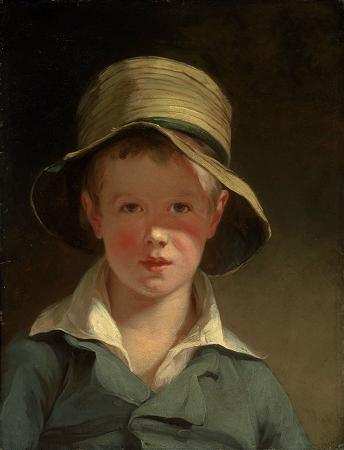Passage of Delaware (1819). Oil on canvas. 372 x 526. The Passage of the Delaware is a large, Neoclassical 1819 oil-on-canvas painting by Thomas Sully. With attention to historical accuracy, the painting depicts George Washington on horseback observing the troops of the American Revolutionary Army in the process of crossing the Delaware River prior to the surprise attacks on Hessian troops on December 26, 1776 at the Battle of Trenton. The image is intended to capture the moment prior to George Washington dismounting his horse and joining his army in crossing the Delaware River. The painting was initially commissioned to be displayed in the North Carolina Capitol but with dimensions of 146.5 high and 207 wide, the work was too large to be displayed in the building so the contract was mutually terminated. The Passage of the Delaware was eventually displayed in the Boston Museum. The museum closed in 1903, and the painting was gifted to the Museum of Fine Arts. It is exhibited in the Museum of Fine Arts, Boston. The Passage of the Delaware was a forerunner of Emanuel Leutze's 1851 painting, Washington Crossing the Delaware. George Washington and the Continental Army had been driven from Fort Lee, New Jersey across the Delaware River and into Pennsylvania by the British Army during the fall of 1776. Washington and his army set up camp in New Hope, Pennsylvania in hopes of preventing the British Army from reaching Philadelphia. The British, who had been following General Washington and his troops during their retreat from Fort Lee, set up camp across the Delaware River in Trenton, New Jersey. Morale in the Continental Army was low following the string of defeats and subsequent retreat from New York City in the fall. Washington felt that the Continental Army was in very bad condition. In hopes of reversing the misfortunes of the fall, raising morale of the troops, and gaining more support, General Washington decided to launch a surprise attack on the Hessian mercenaries camped in Trenton on the morning after Christmas. The attack required the Continental Army to cross the icy Delaware River in the middle of the night with 2,400 men, horses and eighteen cannons. Each soldier took with them three days of rations, blankets, and forty rounds of ammunition. Because of the lack of supplies of the Continental Army, some soldiers lacked proper shoes and had fallen victim to extreme frostbite and had resorted to wrapping their feet in bandages, leaving bloody footprints as they marched. Adding to the logistical challenges of the crossing was the challenge posed by a storm occurring during the night, which dumped snow and sleet on the crossing soldiers. Despite the challenges faced in the crossing, General Washington and the Continental Army took the Hessian garrison in Trenton by surprise and won a long-awaited victory, improving his troops' morale and gaining more support for their efforts against the British. Thomas Sully was an English-born and American-raised artist in the nineteenth century. As a young adult, Sully moved back to England and studied art under the tutelage of Neoclassical artists Benjamin West and Sir Thomas Lawrence. Sully was heavily influenced by West while in London. West instructed Sully to copy works in his personal collection to improve his skills. Similarities between Sully's The Passage of the Delaware and West's The Death of General Wolfe can be seen in the arrangement of officers around the central figure of the painting. Sully's career was dominated by his production of portraits. After completing his studies in England he returned to America and settled in Philadelphia. In Philadelphia he notably painted portraits of Marquis de Lafayette, Thomas Jefferson, Queen Victoria, Edgar Allan Poe, and Andrew Jackson. Sully's work in portraiture was famous for its smooth lines and chiaroscuro. His prolific work in the field led some to think of him as The Prince of American Portraiture. In 1815, following the end of the war of 1812, the General Assembly of the State of North Carolina authorized the production of a statue of George Washington by Antonio Canova. Additionally, they requested the production of two portraits of Washington. Rembrandt Peale and Thomas Sully were approached for the portraits. Rembrandt Peale requested compensation of $1500 for a full-length portrait of George Washington and an additional $1000 for a copy of the work. On the other hand, Sully offered to produce a copy of Gilbert Stuart's rendition of a portrait of George Washington for $400 and an additional original historical portrait of George Washington for $600. Despite Sully's work being dominated by portraiture, he identified himself as an artist focused on History and Portraits.
more...





